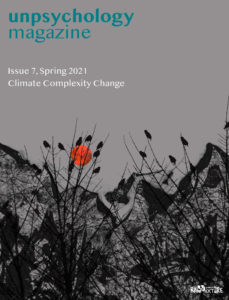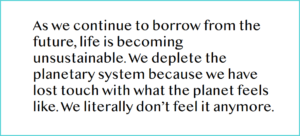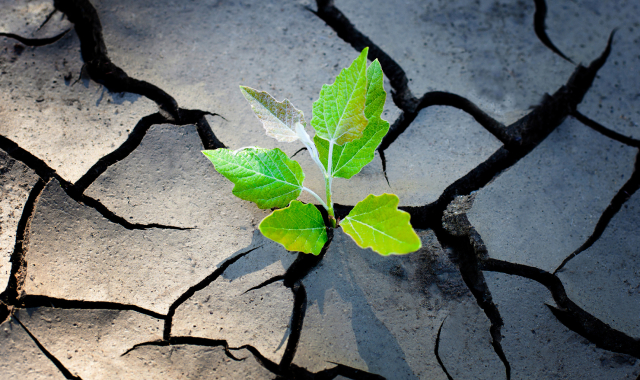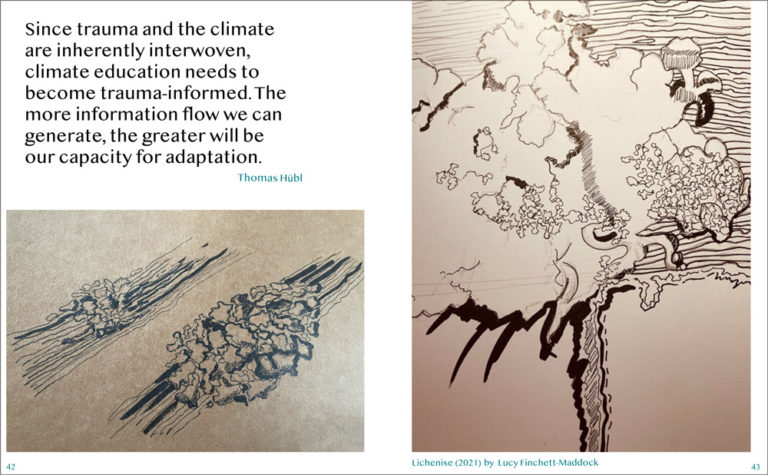This article is published in “Climate Complexity Change”, unpsychology magazine, Issue 7, Spring 2021. Front cover image: Aftermath by Mary Thorp

We stand at a crossroads. Our leading climate experts, scientists, and officials are mining the data on our climate’s trajectory almost daily. Rising carbon in the atmosphere, at levels never seen before. Loss of biodiversity. Extreme weather events. Treaties left unfulfilled. We could blame our socioeconomic structures and political differences for our failure to enact meaningful change. Yet, beneath our arguments and paralysis lies an unconscious landscape constructed around a central pivot: trauma.
Trauma is at the root of our inaction. To understand this, we must first examine how imbalance affects living systems – within our bodies and the earth itself.
Essential Feedback Loops
To maintain stability, every living system generates feedback loops. This flow of information allows a system to adapt and change so it can steer itself, and move in relation to the larger system within which it is embedded. In a living system, feedback loops facilitate a self-regulatory process that adjusts its function, bringing it into balance when equilibrium is threatened.
A flow of information is key to the feedback loop. Without information, there’s no feedback. Our bodies require a well-developed feedback loop system to stay related and attuned to the current needs of life, inside as well as outside.
To use our powers of perception, each of us relies on a continual flow of data. Data continuously streams within our nervous systems, and from there, into other regulatory processes such as our endocrine and digestive system. Right now, massive amounts of data are flowing up and down our spines.
The Architecture of Trauma

For nearly twenty years, my work in collective trauma has helped shape my understanding of how people perceive the world and what motivates their behaviour. I have facilitated dialogue with groups of people throughout the world around healing the wounds brought on by intergenerational and historical traumas. I have witnessed what science has revealed as I listened to hundreds of thousands of people over the years: the most significant disruption in the flow of information within a human system is trauma.
Trauma, by definition, acts as a catalyst for unleashing a series of processes that wreak havoc in the nervous system, which activates into a state of hyper regulation. When a person experiences an overwhelming situation, tremendous stress floods the body and the nervous system. That overload, in turn can lead to disconnection, dissociation, and numbness. To survive, the person’s system literally splits off the physical, emotional, and mental experience of this trauma.
We can respect the intelligent function of the trauma response, which life developed over the course of thousands of years. This very process has helped generations of human beings survive tremendous atrocities, wars, natural disasters, famine, and many other overwhelming situations.
Unintegrated Past
However, as these parts continue to be split off from the whole, they remain unintegrated, which leads us to disconnect from being fully present. We continue to live in the past, as if the traumatic moment has never ended. If this inner fragmentation –the hyperactivated, highly stressed part of us –is not re-integrated, many symptoms and side effects will emerge. When a trauma gets re-triggered, we either overreact or become indifferent.
This evolutionary adaptation process can save our lives, but in the long run we pay the price. If we don’t ultimately integrate that fragmented part, it will create side effects or symptoms that we call suffering. These symptoms will continually call our attention back to that unresolved past. In other words, we have taken a loan from our future that we will ultimately have to repay.
When we lose a conscious, relational awareness of the feedback loops that generate the web of life, we lose something integral. We can only borrow a certain amount of life from our own future. If we don’t find a way to pay it back, we will create a mountain of debt that will collapse on top of our lives.
This, I believe, is the situation we find ourselves in at the moment. As we continue to borrow from the future, life is becoming unsustainable. We deplete the planetary system because we have lost touch with what the planet feels like. We literally don’t feel it anymore. And we have developed technologies and lifestyles which reinforce that downward spiral.
Fueling Trauma
Many of us are running our lives on “trauma fuel”, which translates into a hyperstress that drives our actions. This phenomenon is so insidious we are unable to see it; it has become the new normal. When we are no longer aware that we are living under chronic stress, we come to accept this state as our new baseline. The regulation processes which we require for digestion and regeneration no longer regulate our stress, leading to ‘wear and tear’ of the body which is called allostatic load. This process is happening inside our bodies as we live lifestyles which negatively impact our natural environment.
One point that is missing from the discussion around climate, perhaps because it is so fundamentally simple, is that the body is the natural environment. The environment is not “out there,” as an object; it is the centre of our gravitational force within our own existence. When billions of people burn this “trauma fuel” of their bodies faster than they can replenish it, we deplete our own environment. We deplete our planet.
Field of Separation
When trauma occurs during a person’s development, the normally healthy process of individuation is infused with a sense of separation. This early feeling of disconnection stems from alienating parts of ourselves and emotions we don’t want to feel, which leads to loss of connection with ourselves and our environment. If I can’t access parts of myself, I won’t feel all that exists within the radius of life either.
If I feel alienated or disembodied, I will feel that I am on the planet, not the planet itself. My body reflects the composition of the earth: oxygen, minerals and metals, as well as carbon. This sense of separation has led to a “helicopter mind,” which hovers over nature, exploiting it as we look through the lens of the pain we experienced in the past. There are many ways the mind can harm life when we feel separate.
When we examine what wellbeing is composed of, we find that achieving coherence between three aspects of ourselves is key: body, emotions, and mind. As part of the planet, humans are the living expression of the evolutionary dance of billions of years. Formed out of this expression is the life we are living today. That life is the intelligence of the planet. It’s a fallacy to imagine a planet holding humans within it, as if the planet is an object outside of our awareness.
This dualism between humans and the planet, I believe, is at the root of some of our natural disasters throughout the world. The sixth mass extinction is partly created by the collective trauma story of humanity. Thousands of years of massive traumatisation which are passed on to subsequent generations become repetitive patterns in life. As those patterns beget new traumas, the scale moves beyond the personal, multiplying into numerous phenomena.
Collective Trauma
Collective trauma has been with humanity for hundreds of thousands of years. Massive wounds that remain part of our collective psyche, such as the Holocaust, slavery, racism, colonialism, dictatorships, and other colossal events have morphed into scars that make up the fabric of life, becoming dormant, “cold” collective traumas of humanity. Following those mass atrocities and tragedies, generations continue to be born into that scar tissue. We see this behaviour as symptoms, which are sometimes overt, sometimes subtle. Many of these symptoms and manifestations of collective trauma are hidden under the guise of “that’s how life is.”
Trauma is a wound which leads to further impacts if not treated. If we don’t take care of the cold, historical collective trauma wounds, we will experience massive side effects. The current world shows us very strongly how the symptoms are ramping up.
These cold collective traumas, if left unattended, fester into new “hot” traumas. which manifest as raging wars, natural catastrophes, ethnic cleansing, and other seismic events on the world stage. These events will lead to even more layers of collective trauma if we don’t find ways to integrate this accumulation as soon as possible. Left
unattended, climate disasters and massive changes in the environment will create more frequent catastrophic events, displacing millions of people who will become climate refugees.
We need to confront, and integrate, the cold collective traumas of our past to generate an effective response.
Our hyper reactivity, limited capacity to relate, numbness, and indifference create fertile ground for new conflicts, polarisation and fragmentation. This has happened already in the past and we see this repeated today. On a collective scale, trauma is the sand in the engine that prevents our global communities from instilling change processes we desperately need. The walls we come up against are not political, economic or social; they are the unseen layers of life that hold unintegrated past.
The symptoms of trauma aren’t easily recognised. These may be laziness or indifference, or on the other extreme, hyperactivity. These symptoms are also apparent in the climate conversation. Instead of resorting to these patterns, we can begin to recognize them as manifestations of the frozenness of the past. The fear of change is actually the fear of feeling massive pain arise in our psyches, bodies, emotions, and relationships.
Cultivating a Healing Response
To move towards resolution and restoration, we need skilled teams of trauma professionals. This may sound counter intuitive because all the signs tell us that we don’t have enough time for such activities. Our shared belief is that we need to rush; we are in a race against time. But trauma needs space and time, and the right approach to release the frozen potential into creativity and renewed life energy.
As we examine each of our environmental challenges, we are called to discern whether habits only need to change or whether deeper layers of trauma are at play. Depending on which barrier we are facing, the intervention and approach will be very different. To enact social change, we need this level of specificity. To change habits, we need energy that activates a response, as well as educational initiatives. However, when we come up against trauma, we require a safe and healing environment.
Since trauma and the climate are inherently interwoven, climate education needs to become trauma-informed. The more information flow we can generate, the greater will be our capacity for adaptation. Rapid prototyping, which is often done as part of innovative processes, is only possible when systemic feedback loops are flourishing. To solve our climate crisis, we need to study and consider the integral role of the “inner climate” of our bodies and nervous systems.
If we, as part of the natural system, create a wasteland out of our biosphere, then it tells us a great deal about our inner world. The landscape of our inner collective trauma is being externalised; this is what we continue to turn our world into.
As a world we stand as a crossroads: resolve our current crises, including the climate, either through innovation, or repeat the past. For us to actualize the abundance of innovative ideas and resources available to solve our urgent climate challenges, we must commit first to sustaining the living organisms closest to home: ourselves.
Thomas Hübl (edited by Lori Shridhare)
This article is published in “Climate Complexity Change”, unpsychology magazine, Issue 7, Spring 2021. The issue has 146 pages and contains many excellent articles on climate change, and also artistic works!

